
The Calliphoridae are a family of insects in the order Diptera, with 1,200 known species. The maggot larvae, often used as fishing bait, are known as gentles. The family is known to be polyphyletic, but much remains disputed regarding proper treatment of the constituent taxa, some of which are occasionally accorded family status.

Myiasis is the parasitic infestation of the body of a live animal by fly larvae (maggots) which grow inside the host while feeding on its tissue. Although flies are most commonly attracted to open wounds and urine- or feces-soaked fur, some species can create an infestation even on unbroken skin and have been known to use moist soil and non-myiatic flies as vector agents for their parasitic larvae.
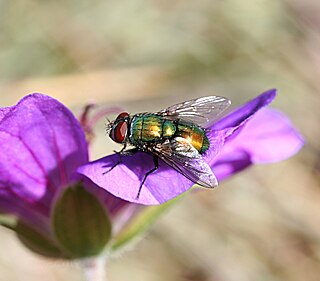
The common green bottle fly is a blowfly found in most areas of the world and is the most well-known of the numerous green bottle fly species. Its body is 10–14 millimetres (0.39–0.55 in) in length – slightly larger than a house fly – and has brilliant, metallic, blue-green or golden coloration with black markings. It has short, sparse black bristles (setae) and three cross-grooves on the thorax. The wings are clear with light brown veins, and the legs and antennae are black. The larvae of the fly may be used for maggot therapy, are commonly used in forensic entomology, and can be the cause of myiasis in livestock and pets.
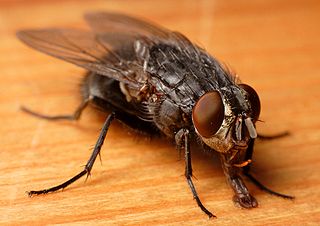
Calliphora is a genus of blow flies, also known as bottle flies, found in most parts of the world, with the highest diversity in Australia. The most widespread species in North America area Calliphora livida, C. vicina, and C. vomitoria.
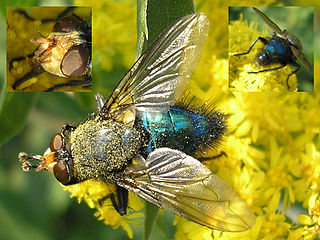
Cynomya mortuorum belongs to the order Diptera, sometimes referred to as "true flies". In English, the only common name occasionally used is "fly of the dead". It has a bluish-green appearance, similar to other Calliphoridae and is found in multiple geographic locations with a preference for colder regions. Belonging to the family Calliphoridae, it has been shown to have forensically relevant implications due to its appearance on carrion. Current research is being done to determine C. mortuorum's level of importance and usage within forensic entomology.

Calliphora vomitoria, known as the blue bottle fly, orange-bearded blue bottle, or bottlebee is a species of blow fly, a species in the family Calliphoridae. Calliphora vomitoria is the type species of the genus Calliphora. It is common throughout many continents including Europe, Americas, and Africa. They are fairly large flies, nearly twice the size of the housefly. They can be easily identified by their shiny, blue bodies.

Lucilia illustris is a member of the fly family Calliphoridae, commonly known as a blow fly. Along with several other species, L. illustris is commonly referred to as a green bottle fly. L. illustris is typically 6–9 mm in length and has a metallic blue-green thorax. The larvae develop in three instars, each with unique developmental properties. The adult fly typically will feed on flowers, but the females need some sort of carrion protein in order to breed and lay eggs.

Calliphora vicina is a member of the family Calliphoridae, which includes blow flies and bottle flies. These flies are important in the field of forensic entomology, being used to estimate the time of a person's death when a corpse is found and then examined. C. vicina is currently one of the most entomologically important fly species for this purpose because it arrives at and colonizes a body following death in consistent timeframes.
Entomological evidence is legal evidence in the form of insects or related artifacts and is a field of study in forensic entomology. Such evidence is used particularly in medicolegal and medicocriminal applications. Insect evidence is customarily used to determine post mortem interval (PMI), but can also be used as evidence of neglect or abuse. It can indicate how long a person was abused/neglected as well as provide important insights into the amount of bodily care given to the neglected or abused person.

The species Lucilia cuprina, formerly named Phaenicia cuprina, is more commonly known as the Australian sheep blowfly.
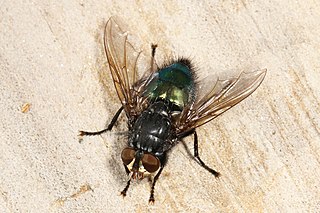
Cynomya cadaverina, also known as the shiny blue bottle fly, is a member of the family Calliphoridae, which includes blow flies as well as bottle flies. In recent years, this family has become a forensically important facet in many medicocriminal investigations in the growing field of forensic entomology. C. cadaverina is specifically important in determining a post-mortem interval, as well as other important factors.

Calliphora livida is a member of the family Calliphoridae, the blow flies. This large family includes the genus Calliphora, the "blue bottle flies". This genus is important in the field of forensic entomology because of its value in post-mortem interval estimation.

Lucilia coeruleiviridis, formerly Phaenecia coeruleiviridis, is commonly known as a green bottle fly, because of its metallic blue-green thorax and abdomen. L. coeruleiviridis was first discovered by French entomologist Pierre-Justin-Marie Macquart in 1855. It belongs to the family Calliphoridae and is one of many forensically important Diptera, as it is often found on decaying substances. L. coeruleiviridis is one of the most ubiquitous blow fly species in the southeastern United States, particularly in the spring and fall months.
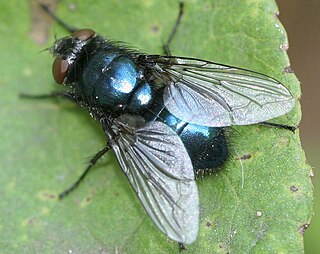
Protophormia terraenovae is commonly called northern blowfly, blue-bottle fly or blue-assed fly. It is distinguished by its deep blue coloration and large size and is an important species throughout the northern hemisphere. This fly is notable for its economic effect as a myiasis pest of livestock and its antibiotic benefits in maggot therapy. Also of interest is P. terraenovae’s importance in forensic investigations: because of their temperature-dependent development and their prominent presence on corpses, the larvae of this species are useful in minimum post-mortem interval (mPMI) determination.
Calliphora latifrons is a species of blue bottle fly.
Calliphora loewi is part of the family Calliphoridae, bottle flies and blowflies, and in the genus Calliphora, blue bottle flies. The genus can be deceiving since C. loewi is not blue. Though this species is rare, it can play an important part in forensic entomology, spreading disease, and decomposing carrion. The life cycle of C. loewi is similar to the life cycle of the genus Calliphora. Since this species is rare there has not been very much research done with this species.
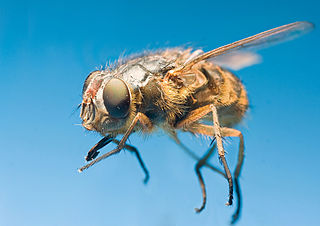
Calliphora hilli is a blow fly species in the genus Calliphora.

Calliphora stygia, commonly known as the brown blowfly, or rango tumaro in Māori, is a species of blow-fly that is found in Australia and New Zealand. The brown blowfly has a grey thorax and yellow-brown abdomen.

Calliphora quadrimaculata, commonly known as the New Zealand blue blowfly and by its Maori name rango pango, is an insect in the genus Calliphora of family Calliphoridae in the order Diptera. This particular blowfly is found throughout New Zealand as well as on Chatham, Auckland, Stewart and Campbell Islands that surround New Zealand. Generally blowfly maggots in New Zealand have to feed on animal tissue or faeces to develop into adult blowflies. However the New Zealand blue blowfly larvae can survive on decaying leaves of snow tussock in alpine regions and reach adult maturity without feeding on any animal tissue.

Many species of flies of the two-winged type, Order Diptera, such as mosquitoes, horse-flies, blow-flies and warble-flies, cause direct parasitic disease to domestic animals, and transmit organisms that cause diseases. These infestations and infections cause distress to companion animals, and in livestock industry the financial costs of these diseases are high. These problems occur wherever domestic animals are reared. This article provides an overview of parasitic flies from a veterinary perspective, with emphasis on the disease-causing relationships between these flies and their host animals. The article is organized following the taxonomic hierarchy of these flies in the phylum Arthropoda, order Insecta. Families and genera of dipteran flies are emphasized rather than many individual species. Disease caused by the feeding activity of the flies is described here under parasitic disease. Disease caused by small pathogenic organisms that pass from the flies to domestic animals is described here under transmitted organisms; prominent examples are provided from the many species.

















